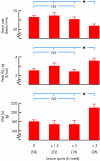Athlete's heart
- PMID: 14617564
- PMCID: PMC1767992
- DOI: 10.1136/heart.89.12.1455
Athlete's heart
Figures



References
-
- Fagard RH. Athlete’s heart: a meta-analysis of the echocardiographic experience. Int J Sports Med 1996;17 (suppl 3):S140–4. ▸ This meta-analysis shows that the classification of left ventricular hypertrophy in athletes as eccentric or concentric is not an absolute or dichotomous concept but has to be considered a relative concept. - PubMed
-
- Fagard RH. Impact of different sports and training on cardiac structure and function. Cardiology Clinics 1997;15:397–412. - PubMed
-
- Pelliccia A, Maron BJ, Spataro A, et al. The upper limit of physiologic cardiac hypertrophy in highly trained elite athletes. N Engl J Med 1991;324:295–301. ▸ This study is important because it attempts to define the upper limit of physiologic cardiac hypertrophy in a large number of highly trained athletes. - PubMed
-
- Pluim BM, Zwinderman AH, van der Laarse A, et al. The athlete’s heart. A meta-analysis of cardiac structure and function. Circulation 1999;100:336–44. ▸ This meta-analysis confirms by use of a different approach that the classification of hypertrophy is not a dichotomous but relative concept. - PubMed
Publication types
MeSH terms
LinkOut - more resources
Full Text Sources
